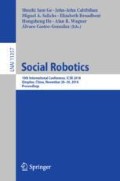Abstract
This paper investigates the relationship between different physiological parameters and three tasks performed by an elderly individual in a 5-days interaction scenario. The physiological parameters investigated are: the galvanic skin response, the facial temperature variation, the heart rate, and the respiration rate. The three tasks were the same during all interactions. More specifically, the participant started with a relaxation period of 3 min, continued with 5 cognitive games, and finished with a news reading task. Each day consisted of two sessions: morning session (at around 11am), and afternoon session (at around 3pm). Our hypotheses were validated, meaning that we can differentiate between the three tasks by looking only at the physiological parameters, and we can differentiate between two difficulty levels of the cognitive games. A discussion of these results is also provided.
Access this chapter
Tax calculation will be finalised at checkout
Purchases are for personal use only
References
Agrigoroaie, R., Tapus, A.: The outcome of a week of intensive cognitive stimulation in an elderly care setup: a pilot test. In: Accepted in RO-MAN (2018)
Agrigoroaie, R., Tapus, A.: Physiological parameters variation based on the sensory stimuli used by a robot in a news reading task. In: Accepted in RO-MAN (2018)
Bellotto, N., et al.: Enrichme integration of ambient intelligence and robotics for AAL. In: AAAI Spring Symposium Series (2017)
Eysenck, S., et al.: A revised version of the psychoticism scale. Pers. Individ. Differ. 6, 21–29 (1985)
Feil-Seifer, D., Mataric, M.J.: Defining socially assistive robotics. In: 9th International Conference on Rehabilitation Robotics (2005)
Femandes, F.E., et al.: Cognitive orientation assessment for older adults using social robots. In: International Conference on Robotics and Biomimetics (2017)
Graf, B., et al.: Robotic home assistant care-o-bot 3-product vision and innovation platform. In: IEEE Workshop on Advanced Robotics and its Social Impacts (2009)
He, W., et al.: An aging world: 2015. International Population Reports (2016)
Horne, J., et al.: A self-assessment questionnaire to determine me in human circadian rhythms. Int. J. Chronobiol. 4, 97–110 (1976)
Ioannou, S., et al.: Proximity and gaze influences facial temperature: a thermal infrared imaging study. Front. Psychol. 5, 845 (2014)
Ioannou, S., et al.: Thermal infrared imaging in psychophysiology: potentialities and limits. Phychophysiology 51, 951–963 (2014)
Merritt, C.R., et al.: Textile-based capacitive sensors for respiration monitoring. IEEE Sens. J. 9, 71–78 (2009)
Nourbakhsh, N., et al.: Detecting users cognitive load by galvanic skin response with affective interference. Trans. Interact. Intell. Syst. 7, 12 (2017)
Pages, J., Marchionni, L., Ferro, F.: Tiago: the modular robot that adapts to different research needs. In: International Workshop on Robot Modularity, IROS (2016)
Papoutsakis, K., et al.: Developing visual competencies for socially assistive robots: the hobbit approach. In: PETRA (2013)
Rahman, H., et al.: Real time heart rate monitoring from facial RGB color video using webcam. In: SAIS (2016)
Setz, C., et al.: Discriminating stress from cognitive load using a wearable EDA device. IEEE Trans. Inf. Technol. Biomed. 14, 410–417 (2010)
Sorostinean, M., et al.: Reliable stress measurement using face temperature variation with a thermal camera in human-robot interaction. In: Humanoids (2015)
Stavropoulos, G., et al.: Automatic action recognition for assistive robots to support MCI patients at home. In: Proceedings of PETRA (2017)
Stroop, J.: Studies of interference in serial verbal reactions. J. Explor. Psychol. 18, 643 (1935)
Tapus, A., et al.: Music therapist robot for individuals with cognitive impairments. In: Proceedings of ACM/IEEE International Conference on HRI (2009)
Turner, J.R., Carroll, D.: Heart rate and oxygen consumption during mental arithmetic, a video game, and graded exercise. Psychophysiology 22, 261–267 (1985)
Acknowledgement
This work was funded and done in the context of the EU Horizon2020 ENRICHME project, Grant Agreement No: 643691
Author information
Authors and Affiliations
Corresponding author
Editor information
Editors and Affiliations
Rights and permissions
Copyright information
© 2018 Springer Nature Switzerland AG
About this paper
Cite this paper
Agrigoroaie, R., Tapus, A. (2018). Physiological Differences Depending on Task Performed in a 5-Day Interaction Scenario Designed for the Elderly: A Pilot Study. In: Ge, S., et al. Social Robotics. ICSR 2018. Lecture Notes in Computer Science(), vol 11357. Springer, Cham. https://doi.org/10.1007/978-3-030-05204-1_19
Download citation
DOI: https://doi.org/10.1007/978-3-030-05204-1_19
Published:
Publisher Name: Springer, Cham
Print ISBN: 978-3-030-05203-4
Online ISBN: 978-3-030-05204-1
eBook Packages: Computer ScienceComputer Science (R0)

